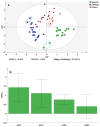Effects of Thiamethoxam and Fenvalerate Residue Levels on Light-Stable Isotopes of Leafy Vegetables
- PMID: 37509747
- PMCID: PMC10378639
- DOI: 10.3390/foods12142655
Effects of Thiamethoxam and Fenvalerate Residue Levels on Light-Stable Isotopes of Leafy Vegetables
Abstract
Accurate identification of the rational and standardized use of pesticides is important for the sustainable development of agriculture while maintaining a high quality. The insecticides thiamethoxam and fenvalerate and the vegetables spinach, cabbage, and lettuce were used here as study objects. Descriptive analysis and primary reaction kinetic equations were used to analyze the changes in metabolic residues of the two insecticides after different numbers of application in three vegetables. The effects of pesticide residue levels on the δ13C, δ15N, δ2H, and δ18O values of vegetables were analyzed by one-way analysis of variance and correlation analysis. Partial least squares discriminant analysis (PLS-DA) was applied to build discrimination models of the vegetables with different pesticide residues based on stable isotopes. The results showed that the first degradation residues of thiamethoxam and fenvalerate in spinach, cabbage, and lettuce conformed to primary reaction kinetic equations, but the degradation half-lives were long, and accumulation occurred in the second application. The differences in the four stable isotope ratios in the control group of the three vegetables were statistically significant, and two-thirds of the stable isotope ratios in the three vegetables with different numbers of pesticide applications were significantly different. The δ13C and δ15N values of spinach, the δ13C, δ15N, and δ2H values of cabbage, and the δ13C, δ15N, δ2H, and δ18O values of lettuce were significantly correlated with different residues of thiamethoxam and/or fenvalerate applications. The control groups of the three vegetables, spinach-thiamethoxam-first, spinach-thiamethoxam-second, cabbage-thiamethoxam-second, cabbage-fenvalerate-first, and lettuce-thiamethoxam-first, were fully identified by PLS-DA models, while the identification models of other vegetables containing pesticide residues still need to be further improved. The results provide technical support for identifying the rational use of pesticides in vegetables and provide a reference method for guaranteeing the authenticity of green and organic vegetables.
Keywords: PLS-DA; cabbage; fenvalerate; lettuce; light-stable isotopes; relationship; spinach; thiamethoxam.
Conflict of interest statement
The authors declare no conflict of interest.
Figures




Similar articles
-
Comparative persistence of pesticides on selected cultivars of specialty vegetables.J Agric Food Chem. 2003 Feb 26;51(5):1328-35. doi: 10.1021/jf020139o. J Agric Food Chem. 2003. PMID: 12590477
-
Impact of sonolytic ozonation (O3/US) on degradation of pesticide residues in fresh vegetables and fruits: Case study of Faisalabad, Pakistan.Ultrason Sonochem. 2021 Nov;79:105799. doi: 10.1016/j.ultsonch.2021.105799. Epub 2021 Oct 16. Ultrason Sonochem. 2021. PMID: 34673342 Free PMC article.
-
Analytical approach, dissipation pattern and risk assessment of pesticide residue in green leafy vegetables: A comprehensive review.Biomed Chromatogr. 2018 Jan;32(1). doi: 10.1002/bmc.4134. Biomed Chromatogr. 2018. PMID: 29134675 Review.
-
Isotope chemometrics determines farming methods and geographical origin of vegetables from Yangtze River Delta Region, China.Food Chem. 2021 Apr 16;342:128379. doi: 10.1016/j.foodchem.2020.128379. Epub 2020 Oct 15. Food Chem. 2021. PMID: 33097333
-
Heavy metal, microbial and pesticides residue contaminations are limiting the potential consumption of green leafy vegetables in Ghana: An overview.Heliyon. 2023 Apr 14;9(4):e15466. doi: 10.1016/j.heliyon.2023.e15466. eCollection 2023 Apr. Heliyon. 2023. PMID: 37151673 Free PMC article. Review.
References
-
- Khursheed A., Rather M.A., Jain V., Wani A.R., Rasool S., Nazir R., Malik N.A., Majid S.A. Plant based natural products as potential ecofriendly and safer biopesticides: A comprehensive overview of their advantages over conventional pesticides, limitations and regulatory aspects. Microb. Pathogenes. 2022;173 Pt A:105854. doi: 10.1016/j.micpath.2022.105854. - DOI - PubMed
-
- Ferreira G., Tucker J., Rakola E., Skorbiansky S.R. Fraud in organic foods. In: Hellberg R.S., Everstine K., Sklare S.A., editors. Food Fraud. Academic Press; Cambridge, MA, USA: 2021. pp. 335–350.
-
- Suman M., Cavanna D., Sammarco G., Lambertini F., Loffi C. Fighting food frauds exploiting chromatography-mass spectrometry technologies: Scenario comparison between solutions in scientific literature and real approaches in place in industrial facilities. TrAC Trends Anal. Chem. 2021;142:116305. doi: 10.1016/j.trac.2021.116305. - DOI
Grants and funding
LinkOut - more resources
Full Text Sources

